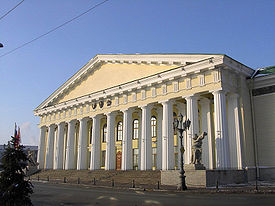
Saint Petersburg Mining Institute
Encyclopedia

Russia
Russia or , officially known as both Russia and the Russian Federation , is a country in northern Eurasia. It is a federal semi-presidential republic, comprising 83 federal subjects...
's oldest higher education institute devoted to engineering. Located in Saint Petersburg
Saint Petersburg
Saint Petersburg is a city and a federal subject of Russia located on the Neva River at the head of the Gulf of Finland on the Baltic Sea...
, the institute is one of the oldest mining schools in Europe, and home to one of the world's finest and most exclusive collections of minerals, gem samples and mining equipment miniatures used for teaching purposes.
The Institute was founded on October 21 OS/ November 1 NS 1773 by order of Empress Catherine II. It was known as the Mining School (Горное училище) until 1804 when it became the Mining Cadet's Corps (Горный кадетский корпус); in 1833, it became the Institute of the Corps of Mining Engineers (Институт корпуса горных инженеров). Since 1866, it has been known as the Mining Institute (Горный институт).
During the Soviet period, it was renamed after Georgi Plekhanov
Georgi Plekhanov
Georgi Valentinovich Plekhanov was a Russian revolutionary and a Marxist theoretician. He was a founder of the Social-Democratic movement in Russia and was one of the first Russians to identify himself as "Marxist." Facing political persecution, Plekhanov emigrated to Switzerland in 1880, where...
, who attended the institute in the 1870s, and became known as "the G. V. Plekhanov
Georgi Plekhanov
Georgi Valentinovich Plekhanov was a Russian revolutionary and a Marxist theoretician. He was a founder of the Social-Democratic movement in Russia and was one of the first Russians to identify himself as "Marxist." Facing political persecution, Plekhanov emigrated to Switzerland in 1880, where...
Leningrad State Mining Institute and Technical University." In 1958-1960 a branch of the institute was opened in Vorkuta and night schools at Slantsy
Slantsy
Slantsy is a town and the administrative center of Slantsevsky District of Leningrad Oblast, Russia, situated on the Plyussa River, west of St. Petersburg. Population: ....
, Monchegorsk, and Kirovsk. The current (as of August 2005) Rector of the Saint Petersburg Mining Institute (SPMI)is Prof. of Mining Engineering Vladimir Stepanovich Litvinenko.
Since 1869 the institute is the headquarter of the Russian Mineralogical Society
Russian Mineralogical Society
The Russian Mineralogical Society is a public scientific organization uniting specialists and scientific groups working in the field of mineralogy and adjacent sciences. RMS was founded in 1817 Saint Petersburg, Russia, and is the world oldest mineralogical society among present...
.
Building
The institute is housed in an Empire style building on the 21st line and the Neva River embankment on the south shore of Vasilievsky IslandVasilievsky Island
Vasilyevsky Island is an island in Saint Petersburg, Russia, bordered by the rivers Bolshaya Neva and Malaya Neva in the south and northeast, and by the Gulf of Finland in the west. Vasilyevsky Island is separated from Dekabristov Island by the Smolenka River...
. It was built in 1806-1811 to a design by the serf-architect Andrey Voronikhin
Andrey Voronikhin
Andrey Nikiforovich Voronikhin was a Russian architect and painter. As a representative of classicism he was also one of the founders of the monumental Russian Empire style...
, who also designed the Kazan Cathedral on Nevsky Prospekt and buildings on Paul I's estate at Pavlovsk
Pavlovsk Palace
Pavlovsk Palace is an 18th-century Russian Imperial residence built by Paul I of Russia near Saint Petersburg. After his death, it became the home of his widow, Maria Feodorovna...
south of the city. The statues flanking the entrance were sculpted by Stepan Pimenov; the reliefs were done by Vasily Demuth-Malinovsky. The Column Hall and the Caryatid Hall were decorated by Michael Scotti.

